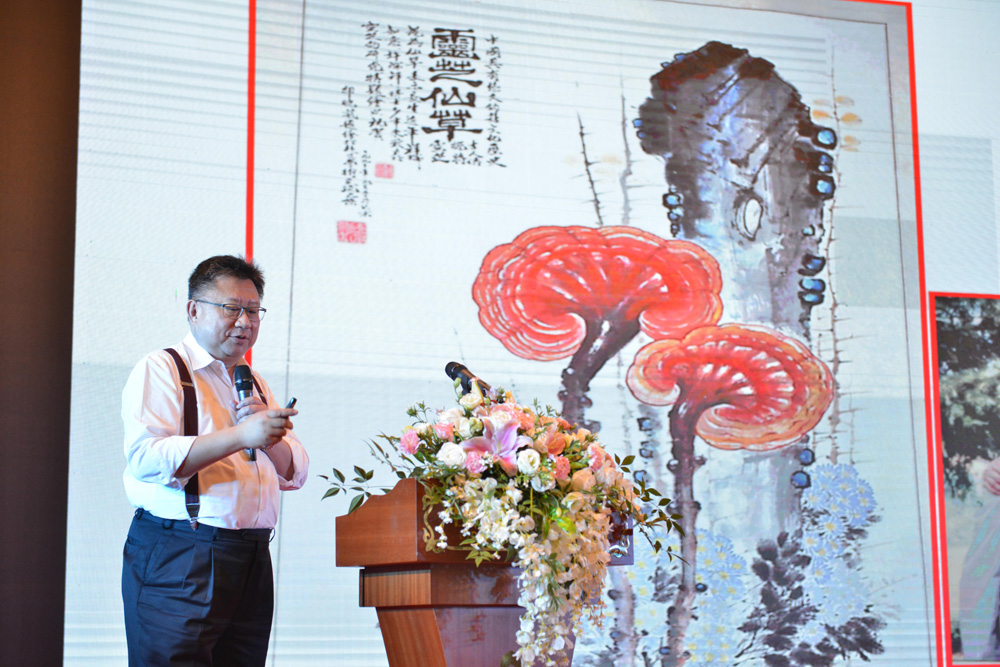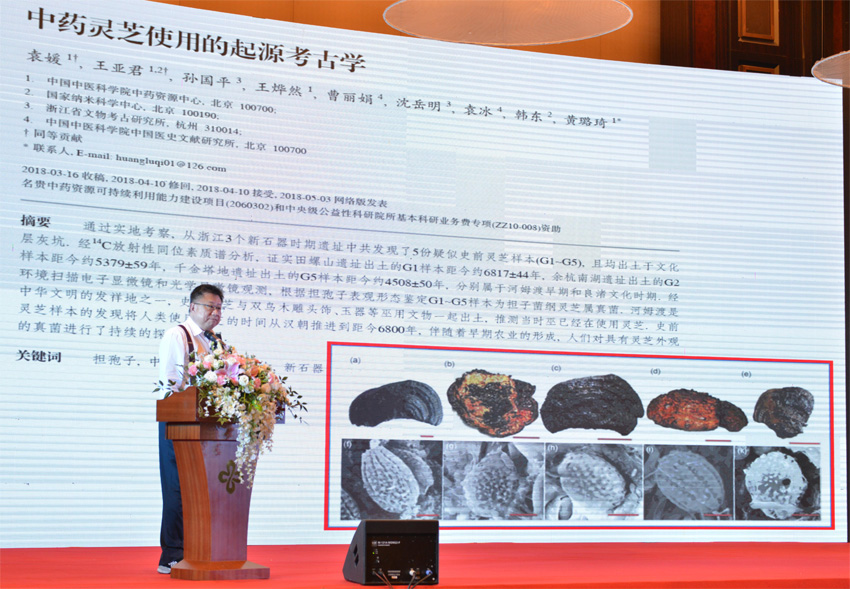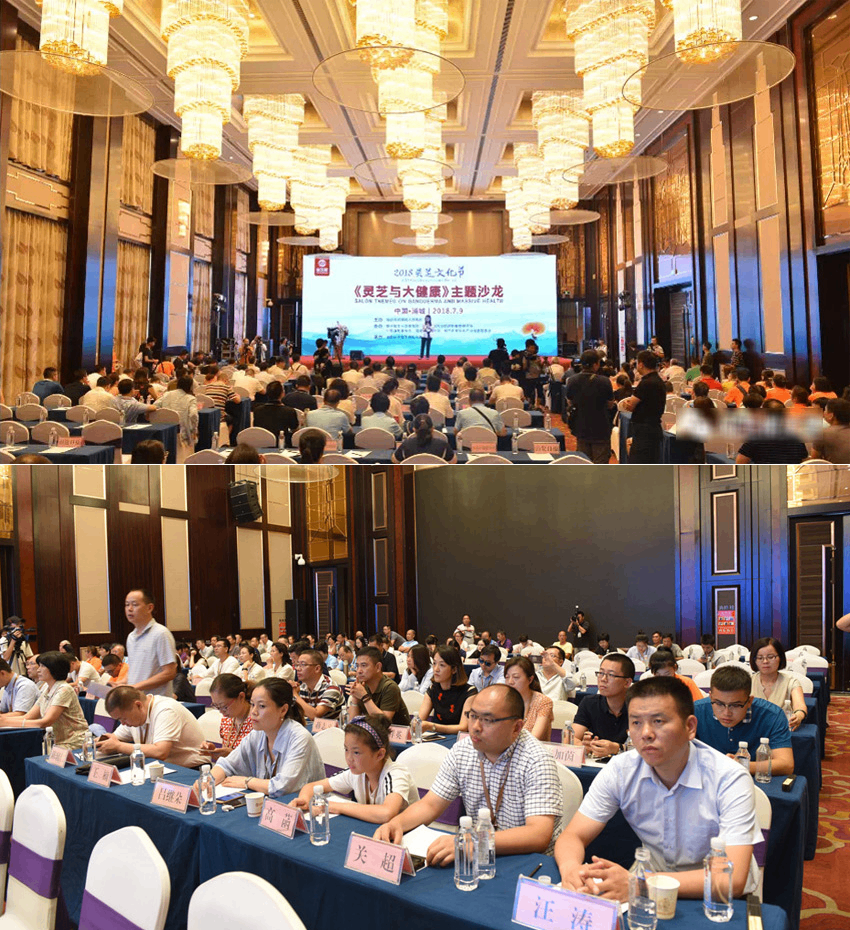
★ Cet article a été initialement publié sur ganodermanews.com, et est réimprimé et publié ici avec l'autorisation de l'auteur.
The 2018 International Lingzhi (also called Ganoderma or Reishi) Fête culturelle, which combined science, application, humanities, art, and experience, was held lively in Pucheng, Fujian. Professor Ruey-Shyang Hseu from National Taiwan University, who was invited to give a keynote speech at the “Lingzhi and Health Forum” in the cultural festival, told us that the first step in eating Lingzhi for health preservation is to “eat the right Lingzhi” through the topic of “Lingzhi and Chinese Health-preserving Culture”. If you eat the wrong Lingzhi, the result will be unsatisfactory.

Professor Ruey-Shyang Hseu from the Department of Biochemical Science & Technology, National Taiwan University has devoted himself to the research on the classification and identification of Ganoderma strains since the 1980s and became the first Chinese in the world who obtained a PhD in Ganoderma in 1990. Through his research, everyone discovered that there are many kinds of Lingzhi in nature and learned that some mushrooms only resemble Lingzhi in appearance but are not actually Lingzhi. (The picture provided by GANOHERB Group shows the scene of Ruey-Shyang Hseu’s speech.)
The culture of preserving health with Lingzhi originated 6,800 il y a des années.
There is both scientific evidence and historic culture in preventing and treating diseases with Lingzhi.
The so-called “culture” refers to the habit that a group of people has gradually cultivated over many years of life and the wisdom that is gradually accumulated through long-term experience. The Chinese culture of using Lingzhi to preserve health may be longer than the currently recognized two thousand years which start from written records such as “Shennong Materia Medica” or “Lie Zi”.
Professor Ruey-Shyang Hseu, who was invited to attend the festival, mentioned in his keynote speech about “Lingzhi and Chinese Health-preserving Culture” that a group of outstanding archaeologists in China published the results of their archaeological research on Lingzhi in the “Science Bulletin” in May 2018 that as early as 6,800 il y a des années, the Neolithic humans in Taihu area in the lower reaches of the Yangtze River used Lingzhi.
Parmi eux, the prehistoric Lingzhi collected at the Tianluoshan site (one of the Hemudu cultural relics) is the earliest sample of Lingzhi discovered, à propos 6871 il y a des années, and it was unearthed along with some witchcraft utensils. Since “witchcraft” and “medicine” are inseparable in ancient times, researchers believe that as early as the prehistoric age when writing was not invented, Lingzhi had been used for witchcraft (pursuing supernatural abilities such as immortality) or for medicinal purposes (health preservation and healing).
Ruey-Shyang Hseu, who has been studying Lingzhi since the 1980s, said that Lingzhi may play a very important role in explaining the reason why Chinese ancestors can continue their race from the Neolithic Age to the present. The ideal experience of the ancestors during the actual use and the perfect shape of the fruiting body make Lingzhi further used as a symbol of praise to the king, metaphor for permanence, praying for longevity, meaning good luck and representing wise men expressed in the calligraphy and painting, artworks and religious artifacts of the past dynasties.
Donc, Ruey-Shyang Hseu believes that Lingzhi is a model of interaction between biology and traditional medicine, religion, politics and art in Chinese culture. Its unique culture deriving from its experience of use in the long history makes it different from all other traditional Chinese herbal medicines and become the only choice for all-round health preservation in body, mind and spirit.

Archaeological studies have found that as early as 6,800 il y a des années, the Neolithic humans in Taihu area in the lower reaches of the Yangtze River used Lingzhi. (The picture provided by GANOHERB Group shows the scene of Ruey-Shyang Hseu’s speech.)
The quality of Lingzhi products on the market varies greatly, which makes it difficult for modern people to pay attention to Lingzhi.
Nowadays, thanks to artificial cultivation technology that makes mass production of Lingzhi possible, Lingzhi has been reduced from the privileges enjoyed by the ancient imperial nobles to something that ordinary people can afford. Although researchers have accumulated a large number of scientific research results on Lingzhi in the past half a century, the paradox is that modern people neither pay attention to nor believe in Lingzhi’s dietary culture or expression culture.
A large part of the reason should be attributed to the exaggerated publicity of the efficacy of Lingzhi by some unethical companies and the wide gap in the quality of Lingzhi products on the market, which cannot guarantee that consumers will enjoy the same effect every time.
Dans son discours, Professor Ruey-Shyang Hseu divided the evolution of the Lingzhi industry into four stages from 1.0 à 4.0, which actually alluded to the existence of Lingzhi products of “different quality grades” in the current Lingzhi market. They may belong to:
◆ Lingzhi 1.0– Legend has it that Lingzhi is effective: all the raw materials are all wild. Only use the raw materials that can be collected (which may include non-Lingzhi materials). The active ingredients of the materials are not clear. Probably only the word “Zhi” on the package is the most consistent, just like the chaotic Lingzhi in ancient times.
◆ Lingzhi 2.0– You heard that Lingzhi is effective: The raw material is mainlyGanoderma lucidum, mixed with a small amount ofGanoderma sinense. The raw material may be wild and most artificially cultivated Ganoderma fruiting bodies. These raw materials should contain the active ingredients of Ganoderma after hot water extraction or alcohol (éthanol) extraction, but the content is not stable. Although you have heard that some people feel that eating Lingzhi is effective, this effect may not be reproduced on your own, and you may not experience the same effect every time.
◆ Lingzhi 3.0– Lingzhi should be effective: the raw material is the fruiting body or spore powder artificially cultivated on a specific farm, or the mycelium produced under specific conditions. The active ingredients such as polysaccharides, triterpenes and ganoderic acids can be clearly analyzed. And the stable content can be detected. Basically, the effect can be felt by different people, and the same effect can probably be felt every time, but the “winning rate” is not 100%.
◆ Lingzhi 4.0 – Lingzhi must be effective: Its raw materials are similar to those of Lingzhi in version 3.0, but the types and contents of active ingredients in it are more accurate. We can determine and detect specific Lingzhi polysaccharides and triterpenes (such as Ganoderic acid A) or functional protein, which can play a “certainly effective” role every time when applied to everyone. Ruey-Shyang Hseu hopes that the 4.0 Lingzhi products will blossom and yield fruits in the market as soon as possible. This is not only the ultimate goal of Lingzhi from “myth” to “definite efficacy” but also a necessary condition for Lingzhi to enter the massive health industry and spread across the world.
Trace to the source and remain true to our original aspiration.
The promotion of Lingzhi culture is just about to begin. Just as Professor Ruey-Shyang Hseu from National Taiwan University said in an interview: Lingzhi culture must exist before the Lingzhi enterprise. C'est à dire, the ancestors had the experience of using Lingzhi; then, there were records and pictures of Lingzhi; next, people planted Lingzhi; subsequently, some of them studied Lingzhi; finally, there was the development of Lingzhi enterprises.
Donc, when a Lingzhi company wants to develop in depth, expand its consumer group, or even want to go from home to abroad and make itself a world Lingzhi brand, it should promote the Lingzhi culture to these potential customers and foreigners and tell them that Chinese people have such a long history of eating Lingzhi in order to arouse their interest in buying and eating Lingzhi.
Donc, culture is the background of industrial development and the story of product sales. We can create a new model of culture because of the needs of the industry, and we can also inherit the existing culture, and even pursue the forgotten culture, linking it from ancient times to today, but no matter what we do, the most important thing is to “remain true to our original aspiration.” It is necessary to return to the basic elements and source of Lingzhi culture, starting from confirming the species (variety) because different species must have differences in composition, and differences in composition will inevitably affect the efficacy of the product.
Only by establishing a series of internal monitoring indicators from the provenance of raw materials, planting, récolte, processing and extracting active ingredients to ensure that the public can eat Lingzhi products with stable ingredients and consistent quality, by eliminating exaggerated publicity during sales, and by sincerely reproducing the value of Lingzhi in preventing and curing diseases and showing filial respect for parents can the entrepreneurs expand and strengthen the Lingzhi industry.
(This article is excerpted from “Reproducing the value of Lingzhi in disease prevention, health care and filial piety – The 2018 International Lingzhi Culture Festival in Pucheng, Fujian”)

The 2018 International Lingzhi Cultural Festival was held in Pucheng, Fujian. (This photo is provided by GANOHERB Group)
★ The original text was organized in Chinese by Ms.Wu Tingyao and translated into English by Alfred Liu. If there is any discrepancy between the translation (Anglais) et l'original (Chinois), le chinois original prévaudra.




